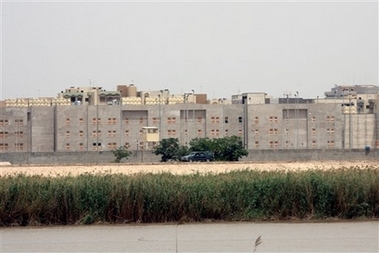Middle East
US Embassy in Iraq to be biggest ever
(AP)
Updated: 2007-05-20 09:25
 |
Large Medium Small |
WASHINGTON - The new US Embassy in Baghdad will be the world's largest and most expensive foreign mission, though it may not be large enough or secure enough to cope with the chaos in Iraq.
 A portion of the new US embassy under construction is seen from across the Tigris river in Baghdad, Saturday, May 19, 2007. [AP]  |
Over the long term, depending on which way the seesaw of sectarian division and grinding warfare teeters, the massive city-within-a-city could prove too enormous for the job of managing diminished US interests in Iraq.
The $592 million embassy occupies a chunk of prime real estate two-thirds the size of Washington's National Mall, with desk space for about 1,000 people behind high, blast-resistant walls. The compound is a symbol both of how much the United States has invested in Iraq and how the circumstances of its involvement are changing.
The embassy is one of the few major projects the administration has undertaken in Iraq that is on schedule and within budget. Still, not all has gone according to plan.
The 21-building complex on the Tigris River was envisioned three years ago partly as a headquarters for the democratic expansion in the Middle East that President Bush identified as the organizing principle for foreign policy in his second term.
The complex quickly could become a white elephant if the US scales back its presence and ambitions in Iraq. Although the US probably will have forces in Iraq for years to come, it is not clear how much of the traditional work of diplomacy can proceed amid the violence and what the future holds for Iraq's government.
"What you have is a situation in which they are building an embassy without really thinking about what its functions are," said Edward Peck, a former top US diplomat in Iraq.
"What kind of embassy is it when everybody lives inside and it's blast-proof, and people are running around with helmets and crouching behind sandbags?"
The compound will have secure apartments for about 615 people. The comfortable but not opulent one-bedrooms have offered hope for State Department staff now doubled up in tinny trailers.
Morale is at an ebb among the embassy staff, most of whom rarely leave the heavily fortified Green Zone during their one-year tours in Iraq. The barricaded zone houses both the current, makeshift US Embassy and the new compound about a mile away. A recent string of mortar attacks has meant further restrictions.
On Saturday, three mortar shells or rockets slammed into a Green Zone compound where British Prime Minister Tony Blair was meeting with Iraqi leaders. The attack wounded one person. One round hit the British Embassy compound.
The new US ambassador, Ryan Crocker, is reviewing staffing and housing needs, and fielding complaints about any suggestion employees either double up again or live elsewhere.
"We do believe that the embassy compound was right-sized at the time that it was presented to the Congress," Secretary of State Condoleezza Rice told a Senate panel this month. "There have been some additional issues since that time. "
Rice's senior adviser on Iraq, David Satterfield, said the embassy is not disproportionately expensive and will serve US interests for years.
"We assume there will be a significant, enduring US presence in Iraq," Satterfield said.
The Baghdad Embassy will open in September and be fully staffed by the end of the year, Satterfield said. US diplomats will move from a dogeared Saddam Hussein-era palace they have occupied since shortly after the 2003 invasion, to the growing irritation of many Iraqis.
| 分享按钮 |